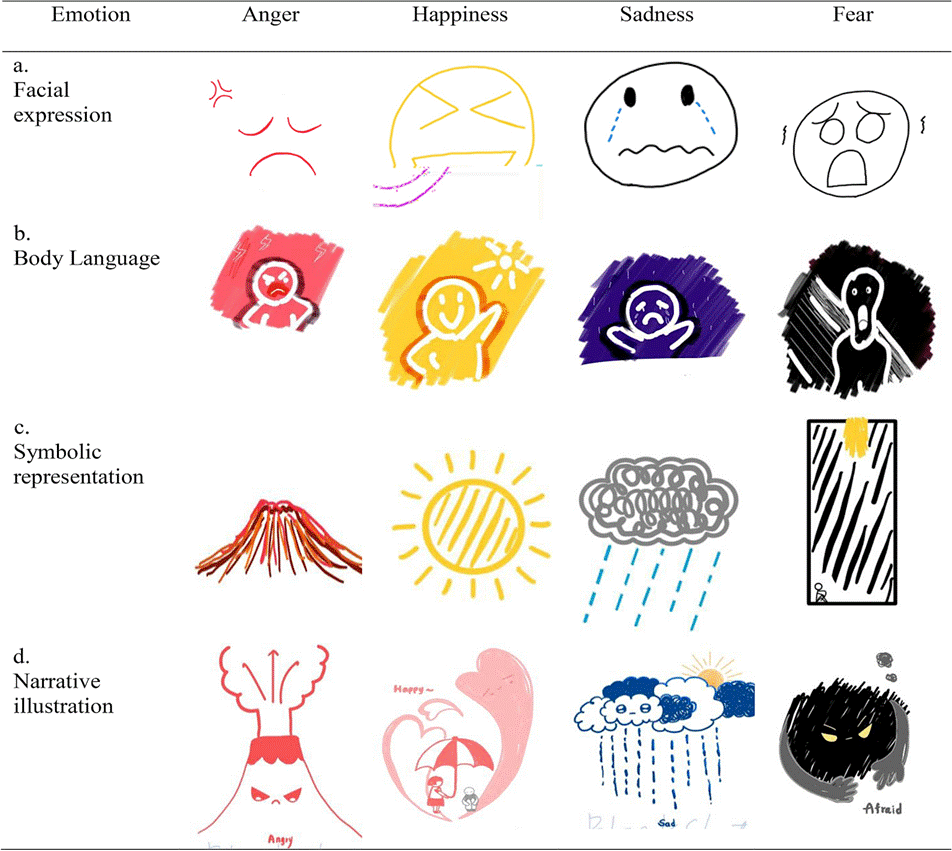Philosophical examination of subjectivity reveals deeper implications for authentic communication. Soren Kierkegaard’s concept that “truth is subjectivity” challenges the assumption that objective writing represents superior communication. According to him, subjective knowledge possesses three essential characteristics that objective analysis cannot replicate:
- It cannot be transferred between individuals
- It remains paradoxical and faith-based rather than purely rational
- It exists concretely rather than abstractly
This philosophical framework explains why human writing, despite its biases and limitations, creates deeper connection with readers. Subjective writing emerges from lived experience, emotional memory, and cultural understanding provide authenticity and meaning that purely objective analysis cannot achieve.
The Authentic Voice in Literature and Journalism

Illustrations of anger, happiness, sadness, and fear shown through facial expressions, body language, symbolic icons, and narrative sketches.
Literary research demonstrates that authentic voice emerges through strategic vulnerability—the conscious selection of personal details that construct truthful and resonant messages. This authenticity cannot be simulated through algorithmic processes because it requires the integration of personal experience with cultural awareness and emotional intelligence.[18]
Studies in journalism and literary criticism reveal that readers consistently prefer content with clear authorial voice over neutral, objective reporting when seeking emotional engagement and personal connection. The most impactful writing combines factual accuracy with personal perspective, creating what researchers term “strategic subjectivity”—deliberate use of personal viewpoint to enhance rather than compromise truth-telling.[20][21][22][18]
Emotional Depth and Creative Decision-Making
The Psychology of Creative Expression

A person preparing to write in a journal, symbolizing authentic writing and personal reflection.
Human creativity operates through complex psychological processes that integrate emotion, experience, and cultural context in ways that current AI cannot replicate. Research in organizational psychology demonstrates that creativity enhances decision-making quality by enabling the generation of novel alternatives and providing new frameworks for problem analysis.[23][24][25][26][27]
Creative writing specifically requires what psychologists term “emotional intelligence”—the capacity to recognize, understand, and manage emotions in ways that enhance communication effectiveness. This emotional intelligence manifests in writing through the ability to convey empathy, vulnerability, and cultural nuance that creates authentic human connection.[28][29]
The Neuroscience of Emotional Engagement
Neurological research reveals that engaging with human-authored literature activates brain regions associated with empathy and emotional comprehension in ways that AI-generated content does not. The emotional depth in authentic writing fosters connections that transcend cultural and temporal barriers, creating what literary scholars describe as “transcendent” communication.[30][31]
Studies comparing human and AI-generated creative content consistently demonstrate that human writers excel in strategic storytelling, emotional depth navigation, and cultural adaptation—capabilities that require the integration of personal bias with creative expression. This suggests that human bias, rather than being a limitation to overcome, represents a fundamental component of meaningful communication.[23][32]
The Cultural and Social Implications
Bias as Cultural Expression

People gathered around a campfire at night in a natural setting, fostering storytelling and connection.
Cross-cultural research reveals that bias and subjectivity serve important social functions by preserving cultural knowledge and facilitating group identity. Different cultural traditions approach emotional expression uniquely—Eastern literature often emphasizes collective emotional experiences while Western literature focuses on individual emotional struggles—yet both rely on cultural bias to create authentic resonance with their intended audiences.[28][31][33]
This cultural specificity of bias explains why AI writing, despite technical proficiency, often feels generic or culturally tone-deaf. Human writers draw from cultural understanding and personal experience to create content that resonates with specific audiences in ways that algorithmic pattern matching cannot achieve.[11][34]
The Social Function of Authentic Storytelling
Research in narrative communication demonstrates that authentic storytelling serves crucial social functions: building community through shared understanding, fostering empathy through perspective-sharing, and creating space for collective emotional processing. These functions require the integration of personal bias with conscious communication choices—exactly the combination that current AI systems cannot achieve.[18][35][19]
Human bias in storytelling also serves a truth-telling function by acknowledging the subjective nature of all communication. Rather than pretending to objective neutrality that doesn’t exist, biased human writing offers transparent subjectivity that allows readers to evaluate and contextualize the information they receive.[17][18]
Practical Implications for Content Creation
The Future of Human-AI Collaboration

Quote by Tracy K. Smith on poetry providing vocabulary for complex feelings and evolving human experiences, featured by the Cleveland Rape Crisis Center.
Current research suggests that the most effective content creation emerges from human-AI collaboration that leverages the technical capabilities of AI while preserving the authentic voice and cultural intelligence of human writers. This collaboration allows AI to handle technical tasks like grammar checking, fact verification, and structural organization while humans focus on creative vision, emotional resonance, and cultural context.[24][25][36]
However, this collaboration must preserve what researchers identify as the irreplaceable elements of human writing: personal experience, emotional authenticity, and cultural understanding. The challenge lies in using AI tools without compromising the very biases and subjectivity that make human writing meaningful.[23][32]
Preserving Authenticity in Digital Communication
The proliferation of AI-generated content creates new challenges for authentic communication. As AI becomes increasingly sophisticated at mimicking human writing styles, the value of genuinely authentic, biased human expression increases correspondingly. This suggests that rather than trying to eliminate bias from writing, the focus should be on transparent acknowledgment of bias and conscious use of subjective perspective to enhance rather than compromise communication effectiveness.[6][37][34]
Conclusion: Embracing the Beautiful Imperfection
The paradox of human bias in writing reveals a fundamental truth about communication: our supposed cognitive limitations actually constitute our greatest strength as communicators. While AI systems excel at technical accuracy and consistency, they lack the experiential foundation, emotional intelligence, and cultural authenticity that emerge from biased human perspective.[10][18][23]
Rather than viewing bias as a limitation to overcome, we should recognize it as the source of authentic voice, emotional resonance, and cultural connection that makes communication meaningful. The challenge in our increasingly AI-mediated world is not to eliminate human bias, but to acknowledge it transparently and use it consciously to create communication that truly serves human understanding and connection.[18][17][32]
The future of writing lies not in the elimination of human bias, but in the conscious integration of human subjectivity with technological capability. By embracing our biased nature while leveraging AI’s technical strengths, we can create communication that combines accuracy with authenticity, efficiency with emotional depth, and objectivity with the irreplaceable human perspective that makes words truly meaningful.[24][36]
In the end, humans will indeed do anything to appear neutral, yet we cannot escape our fundamental nature as biased, judgmental beings. It is precisely this inescapable bias—this beautiful human imperfection—that AI writing, no matter how technically sophisticated, remains hollow without. Our biases are not bugs to be fixed, but features that make us human, and our writing authentic.